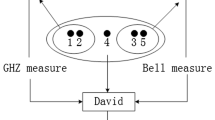Abstract
Improvement of a quantum proxy blind signature scheme is proposed in this paper. Six-qubit entangled state functions as quantum channel. In our scheme, a trust party Trent is introduced so as to avoid David’s dishonest behavior. The receiver David verifies the signature with the help of Trent in our scheme. The scheme uses the physical characteristics of quantum mechanics to implement message blinding, delegation, signature and verification. Security analysis proves that our scheme has the properties of undeniability, unforgeability, anonymity and can resist some common attacks.

Similar content being viewed by others
References
Shor, P.W.: Inproceedings of the 35th annual IEEE symposium on foundations of computer science, pp 124–134 (1994)
Mambo, M., Usuda, K., Okamoto, E.: Proxy signatures for delegating signing operation. In: Proceedings of the 3rd ACM Conference on Computer and Communications Security, pp 48–57, New Delhi (1996)
Wen, X.J., Liu, Y., Zhang, P.Y.: Digital multi-signature protocol based on teleportation. Wuhan Univ. J. Nat. Sci. 12(1), 29–32 (2007)
Wen, X.J., Liu, Y., Zhou, N.R.: Secure quantum telephone. Opt. Commun. 275(1), 278–282 (2007)
Li, Q., Chan, W.H., Long, D.Y.: Arbitrated quantum signature scheme using Bell states. Phys. Rev. A 79(5), 054307 (2009)
Wang, T.Y., Wei, Z.L.: One-time proxy signature based on quantum cryptography. Quantum Inf. Process. 11(2), 455–463 (2012)
Zhang, K.J., Zhang, W.W., Li, D.: Improving the security of arbitrated quantum signature gainst the forgery attack. Quantum Inf. Process. 12(8), 2655–2699 (2013)
Zou, X.F., Qiu, D.W.: Attack and improvements of fair quantum blind signature schemes. Quantum Inf. Process. 12(6), 2071–2085 (2013)
Wang, T.Y., Cai, X.Q.: Security of a sessional blind signature based on quantum cryptograph. Quantum Inf. Process. 13(8), 1677–1685 (2014)
Wang, T.Y., Cai, X.Q., Ren, Y.L., et al.: Security of quantum digital signatures for classical messages. Sci. Rep. 5, 9231 (2015)
Barnum, H., Crepeau, C., Gottesman, D., et al.: . In: Proceedings of the 43th annual IEEE symposium on foundations of computer science, pp 449–458 (2002)
Gottesman, D., Chuang, I.L.: Quantum digital signature arXiv:quant-ph/0105032v2 (2001)
Zeng, G.H., Keitel, C.H.: Arbitrated quantum-signature scheme. Phys. Rev. A 65, 042312 (2002)
Zeng, G.H.: Reply to Comment on Arbitrated quantum-signature scheme. Phys. Rev. A 78, 016301 (2008)
Lee, H., Hong, C., Kim, J., et al.: Arbitrated quantum signature scheme with message recovery. Phys. Lett. A 321, 295–300 (2004)
Cao, H.J., Wang, H.S., Li, P.F.: Quantum proxy multi-signature scheme using genuinely entangled six-qubits state. Int. J. Theor. Phys. 52(4), 1188–1193 (2013)
Cao, H.J., Huang, J., Yu, Y.F., et al.: A quantum proxy signature scheme based on genuine five-qubit entangled state. Int. J. Theor. Phys. 53(9), 3095–3100 (2014)
Chaum, D.: Blind signature for untraceable payments. Advances in cryptology. In: Proceeding of Crypto82, pp 199–203. Springer, New York (1983)
Wen, X.J., Niu, X.M., Ji, L.P.: A weak blind signature scheme based on quantum cryptography. Opt. Commun. 282(4), 666–669 (2008)
Wang, M.M., Chen, X.B., Yang, Y.X.: A blind quantum signature protocol using the GHZ states. Sci. China Phys. Mech. 56, 1636–1641 (2013)
Shao, A.X., Zhang, J.Z., Xie, S.C.: A quantum multi-proxy multi-blind-signature scheme based on genuine six-qubit entangled state. Int. J. Theor. Phys. 55, 5216–5224 (2016)
Yang, Y.Y., Xie, S.C., Zhang, J.Z.: An Improved Quantum Proxy Blind Signature Scheme Based on Genuine Seven-Qubit Entangled State. Int. J. Theor. Phys. 56(7), 2293–2302 (2017)
Zhu, H.P.: Quantum state sharing of an arbitrary single-Atom state by using a genuine six-atom entangled state in cavity QED. Int. J. Theor. Phys. 52(5), 1588–1592 (2013)
Shor, P.W., Preskill, J.: Simple proof of security of the BB84 quantum key distribution protocol. Phys. Rev. Lett. 85(2), 441–444 (2000)
Mayers, D.: Unconditional security in quantum cryptography. J. Assoc.: Comput. Math. 48(1), 351–406 (2001)
Inamon, H., Lutkenhaus, N., Mayers, D.: Unconditional security of practical quantum key distribution. Eur. Phys. J. D 41(3), 599–627 (2007)
Guo, W., Zhang, J.Z., Li, Y.P., et al.: Multi-proxy strong blind quantum signature scheme. Int. J. Theor. Phys. 55(8), 3524–3536 (2016)
Zhang, K.J., Jia, H.Y.: Cryptanalysis of a quantum proxy weak blind signature scheme. Int. J. Theor. Phys. 54, 582–588 (2015)
Tian, J.H., Zhang, J.Z., Li, Y.P.: A quantum multi-proxy blind signature scheme based on genuine four-qubit entangled state. Int. J. Theor. Phys, 55(2) 809–816 (2015)
Acknowledgements
This work is supported by the National Natural Science Foundation of China (Grant No. 61402275, 61402015, 61273311), the Natural Science Foundation of Shaanxi Province (Grant No. 2015JM6263, 2016JM6069), and the Fundamental Research Funds for the Central Universities(Grant No. GK201402004).
Author information
Authors and Affiliations
Corresponding author
Rights and permissions
About this article
Cite this article
Zhang, JL., Zhang, JZ. & Xie, SC. Improvement of a Quantum Proxy Blind Signature Scheme. Int J Theor Phys 57, 1612–1621 (2018). https://doi.org/10.1007/s10773-018-3688-4
Received:
Accepted:
Published:
Issue Date:
DOI: https://doi.org/10.1007/s10773-018-3688-4




